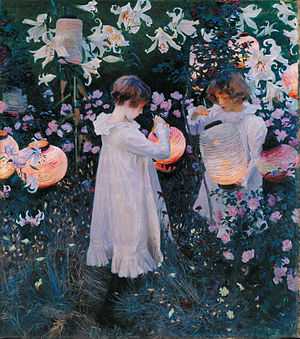Carnation, Lily, Lily, Rose
 | |
| Artist | John Singer Sargent |
|---|---|
| Year | 1885 |
| Type | Oil on canvas |
| Dimensions | 174.0 cm × 153.7 cm (68.5 in × 60.5 in) |
| Location | Tate Britain |
Carnation, Lily, Lily, Rose is an oil-on-canvas painting made by the Anglo-American painter John Singer Sargent in 1885-6.[1]
The painting depicts two small children dressed in white, lighting softly-glowing Chinese lanterns with tapers as day turns to evening, in a garden strewn with pink roses, accents of yellow carnations and tall white lilies (possibly the Japanese mountain lily, Lilium auratum) behind. The painting is dominated by green foliage, with no horizon or other horizontal line to give the painting depth. The viewer seems to be simultaneously on a level with the children, but also looking down on them from above. The two subjects, the daughters of the illustrator Frederick Barnard - a friend of Sargent's, are Dolly and Polly Barnard; Dolly, left, was aged 11 and Polly, right, 7 years, chosen for their blonde hair (replacing Sargent's original model, Millet's 5-year-old daughter, dark-haired Katherine). The title comes from the refrain of a popular song "Ye Shepherds Tell Me" (also known as The Wreath) by Joseph Mazzinghi, a pastoral glee for a trio of male voices, which mentions Flora wearing "A wreath around her head, around her head she wore, Carnation, lily, lily, rose".
Sargent's painting can be read as a botanical allegory of flower-maidens, with subtle sexual overtones of lighting a lantern (slang in French for vagina), and the taper as a symbolic paintbrush (also used to hand-pollinate flowers) used to illuminate the paper of the lantern in the same way that a painter uses a paintbrush to create an image on a canvas.
The work is set in an English garden at Farnham House in Broadway in the Cotswolds, south of Stratford-upon-Avon, where Sargent spent the summer of 1885 with painter Francis Davis Millet shortly after moving to England from Paris to escape the scandal caused by his 1884 painting Portrait of Madame X. Sargent took inspiration from the lanterns that he saw hanging among trees and lilies while boating on the River Thames at Pangbourne with American artist Edwin Austin Abbey in September 1885, during which trip Sargent had injured his head on an underwater object when diving into the water. Sargent wanted to capture the exact level of light at dusk so he painted the picture en plein air - out of doors, in the Impressionist manner. Every day from September to November 1885, he painted in the very few minutes when the light was perfect, giving the picture an overall purple tint of evening. The flowers in the garden died as summer turned to autumn, and they were replaced with artificial flowers. Sargent resumed painting the following summer at the Millet new home nearby in Broadway, and finally finished the painting by the end of October 1886. In the course of working, Sargent cut down the rectangular canvas, removing approximately 2 feet (61 cm) from the left side, to leave an approximately square shape.
The work received a mixed reception at the Royal Academy summer exhibition in 1887, with some criticising his "Frenchified" style. However, there was also much praise, and Sir Frederic Leighton, President of the Royal Academy, encouraged the Tate Gallery to buy the painting later that year, using money from the Chantrey Bequest. It was the first of Sargent's works to be acquired by a public museum. The painting remains part of the collection of the Tate Gallery, and is displayed at Tate Britain.
References
- ↑ "Tate Gallery". Retrieved February 5, 2013.
- A video discussion about Sargent's Carnation, Lily, Lily, Rose from Smarthistory at Khan Academy.
- A Touch of Blossom: John Singer Sargent and the Queer Flora of Fin-de-siècle Art, Alison Mairi Syme, p.155-166
- Uncanny Spectacle: The Public Career of the Young John Singer Sargent ... edited by Marc Simpson, John Singer (ART) Sargent p.155-6
- John S. Sargent, His Life and Work: With an Exhaustive Catalogue of His Works, William Howe Downes p.24, 140-1
Further reading
| Wikimedia Commons has media related to Carnation Lily Lily Rose by John Singer Sargent. |
- Herdrich, Stephanie L & Weinberg, H. Barbara (2000). American drawings and watercolors in the Metropolitan Museum of Art: John Singer Sargent. New York: The Metropolitan Museum of Art. ISBN 0870999524.
| ||||||||||||||